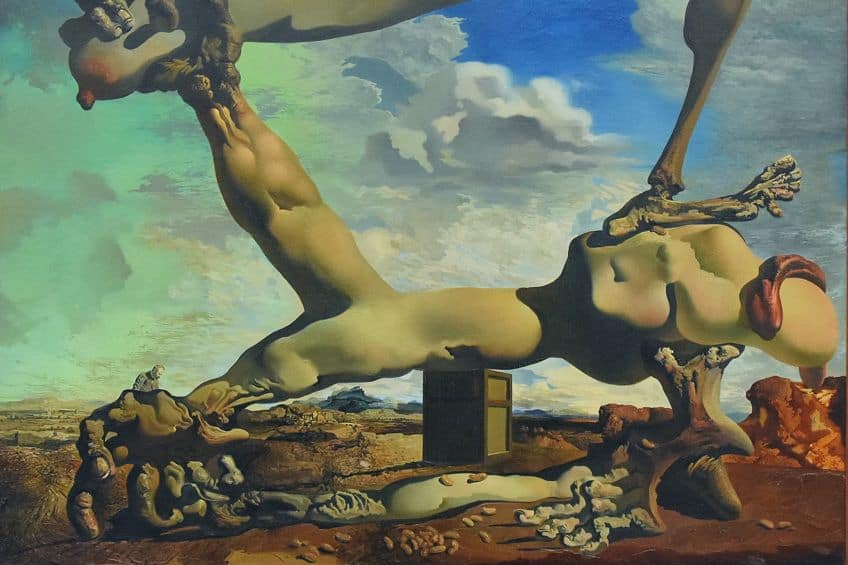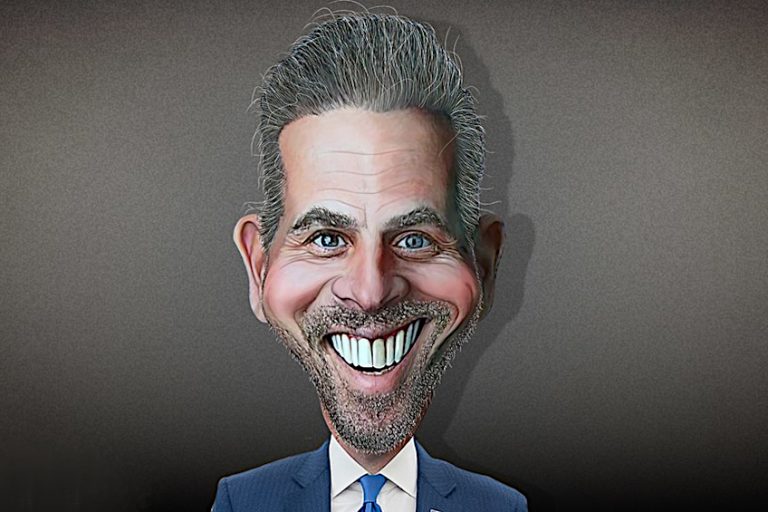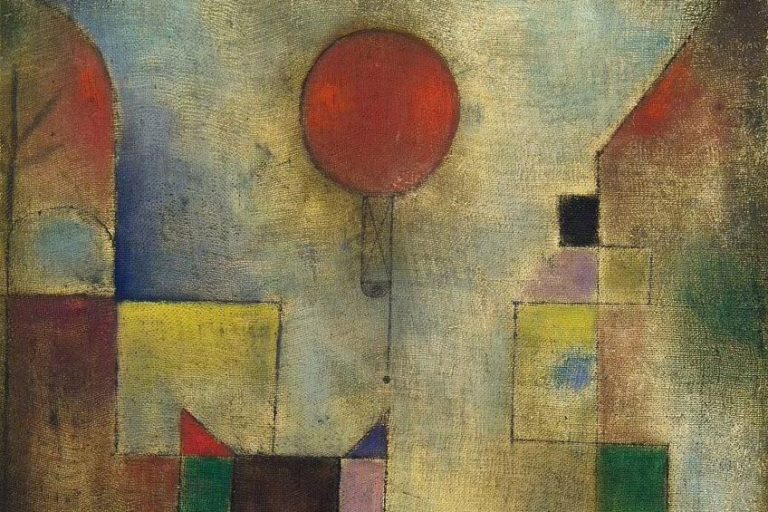“Soft Construction with Boiled Beans (Premonition of Civil War)”
Soft Construction with Boiled Beans (Premonition of Civil War) is a surrealist masterpiece by Salvador Dalí, created in 1936. This striking painting, renowned for its visceral and grotesque imagery, prefigures the horrors of the Spanish Civil War, which erupted later that same year. Dalí’s work is a nightmarish vision of a monstrous figure tearing itself apart, symbolizing the internal conflict and self-destruction of Spain. The inclusion of boiled beans in the title and composition adds a mundane yet unsettling contrast to the chaos depicted, exemplifying Dalí’s unique ability to blend the ordinary with the fantastical. This painting stands as a poignant and prophetic commentary on the devastating impact of civil strife.
Key Takeaways
- Dalí’s painting predicts the Spanish Civil War’s horrors.
- The artwork symbolizes internal conflict and self-destruction.
- Soft Construction with Boiled Beans is held at the Philadelphia Museum of Art.
Historical Context and Inspiration
| Artist | Salvador Dalí (1904 – 1989) |
| Date Created | 1936 |
| Medium | Oil on canvas |
| Genre | Surrealism |
| Period/Movement | Surrealism |
| Dimensions (cm) | 100 x 99 |
| Series/Versions | None |
| Where Is It Housed? | Philadelphia Museum of Art, Philadelphia, United States |
| What It Is Worth | Estimated at $20-40 million (value based on recent market trends) |
Salvador Dalí’s Soft Construction with Boiled Beans (Premonition of Civil War) is a compelling piece of Surrealist art created in 1936. Dalí crafted this vivid painting to capture the chaos and brutality of the Spanish Civil War, which began just six months after he completed the work. The artist’s eerie foresight immortalizes a nation on the brink of destruction. The painting shows a twisted, monstrous figure that seems to be tearing itself apart, symbolizing the self-inflicted wounds of a country divided by conflict. Dalí’s choice of soft, almost melting beans adds to the surreal and unsettling atmosphere, highlighting the absurdity and grotesque nature of civil strife. Created during his time in Paris, this work reflects Dalí’s deep fears for his homeland.

Today, Soft Construction with Boiled Beans (Premonition of Civil War) is housed in the Philadelphia Museum of Art, where it continues to draw the attention of art enthusiasts and historians alike. The painting not only showcases Dalí’s technical skill and imaginative prowess but also serves as a poignant reminder of the impact of war on a nation’s psyche and the enduring relevance of artistic expression in times of crisis.
Spanish Civil War Background
The Spanish Civil War broke out in 1936, pitting Francisco Franco’s right-wing nationalists against the leftist Republican government. The conflict caused significant destruction and influenced artists like Dalí, who painted this work just months before the war started.
It shows the devastating impact of civil conflict, with distorted, suffering bodies depicting the internal divisions of Spain.
Influence of the Surrealist Movement
Dalí was a prominent figure in the Surrealist movement, which used dreamlike images and absurd scenes to explore the unconscious mind. Living in Paris, he was deeply influenced by Surrealist principles. Soft Construction with Boiled Beans (Premonition of Civil War) shows this influence through its bizarre and dramatic imagery. Dalí’s involvement with the Surrealists allowed him to use his art to comment on the political chaos around him.

Comparative Works
Dalí’s contemporary, Pablo Picasso, also addressed the Spanish Civil War in his work, most notably in the painting, Guernica. While Picasso’s style was more direct and stark, Dalí’s Surrealist approach offered a distorted, almost fantastical view of the horrors. Another significant figure was poet Federico García Lorca, whose works also reflected the turmoil of the era.
Both Dalí and Lorca used their art to process and represent their experiences during this dark period in Spanish history.
Artistic Analysis of the Painting
Soft Construction with Boiled Beans (Premonition of Civil War) by Salvador Dalí is a surrealist piece that conveys the horrors of the Spanish Civil War through powerful symbolism and technique. He created an allegory using grotesque imagery, and his prophetic style adds depth to the artwork.

Symbolism and Metaphor
The painting features deformed, massive limbs representing the twisted nature of the civil conflict. The contorted body parts mirror the violent struggle and the self-destruction it caused. The scattered boiled beans symbolize decay and putrefaction, reinforcing the message of violence and suffering. Dalí uses these elements to create a haunting and harrowing atmosphere, emphasizing the internal suffering of his homeland.
Dalí’s choice of surrealist imagery uncovers hidden fears and anxieties, making the symbolism resonate deeply.

Technique and Composition
Dalí painted the piece using oil on canvas. His use of the “paranoic-critical method” gives the painting a unique appearance, where various elements morph into symbolic forms. The composition is chaotic yet methodical, with each element contributing to the overarching allegory. His meticulous attention to texture, especially in the depiction of skin and beans, adds a tactile quality to the work. The grotesque colors and exaggerated forms are deliberate, carefully enhancing the unsettling nature of the scene.
Dalí’s technical prowess is evident in the detailed, surrealist elements.

Prophetic Aspects and Premonitions
Dalí painted this artwork just months before the Spanish Civil War broke out. He claimed to have a premonition of the horrific events, making the piece prophetic. The prophetic aspects are evident in the tortured expressions and twisted forms. These elements foreshadow the real suffering Spain would endure. The shattered and deformed limbs could also be seen as a metaphor for a fragmented country. The precision with which he predicted the atmosphere of conflict underscores his visionary and almost mystical perspective on unfolding events.
His eerie accuracy contributes to the painting’s lasting impact and historical significance.

Salvador Dalí’s Philosophical and Psychological Themes
Salvador Dalí’s works often reflect deep philosophical and psychological themes influenced by Sigmund Freud, his exploration of the subconscious mind, and his personal symbolism.
These elements come together to create a complex tapestry of thought and emotion in his paintings.
Influence of Sigmund Freud
Sigmund Freud’s theories had a significant impact on Dalí. Freud’s ideas about the unconscious mind and dreams intrigued Dalí, prompting him to delve into his own subconscious. Dalí admired Freud’s work on dreams and psychoanalysis. He believed that understanding these concepts could help uncover hidden truths about human nature and creativity. Dalí’s paintings often feature dream-like scenarios and bizarre, irrational images, a direct nod to Freudian influence. The use of hallucinations and surreal landscapes in his art can be seen as a visual representation of repressed emotions and desires escaping from the subconscious mind.

Exploration of Subconscious
Dalí’s exploration of the subconscious is evident in his fascination with dreams and monsters. He was fascinated by the inner workings of the mind and how it reveals itself through dreams and irrational thoughts. He used his art to capture the essence of the subconscious. Dalí believed that by exploring these hidden aspects, he could create a deeper connection with the audience. His famous paranoiac-critical method allowed him to tap into his subconscious.
This technique enabled Dalí to create multiple interpretations within the same image, encouraging viewers to explore their own subconscious thoughts while engaging with his work.
Dalí’s Personal Symbolism
Dalí’s paintings are rich with personal symbolism. These symbols often relate to his dreams, childhood experiences, and personal fears. He repeatedly used certain images, like melting clocks, to represent the fluidity of time and the ephemeral nature of reality. Boiled beans, a recurring motif in his works, symbolize the violence and suffering he perceived in society. This is particularly evident in “Soft Construction with Boiled Beans,” where the bizarre, almost monstrous shapes represent the inner turmoil and chaos stemming from the Spanish Civil War. His personal struggles and unique worldview are embedded in these symbols, offering a window into his inner world. Each symbol in Dalí’s work holds a particular significance, often linked to his philosophical and psychological inquiries.

Impact and Legacy
Soft Construction with Boiled Beans (Premonition of Civil War) by Salvador Dalí has left a lasting imprint on the world of art. It holds a significant place in art history, is housed in a notable museum collection, and has influenced popular culture. This painting is an important piece in the 20th century and is a prime example of Surrealist art. Dalí used oil on canvas to create a vivid and disturbing image that foretells the horrors of the Spanish Civil War. Art critic Robert Hughes described it as a powerful allegory of self-destruction.
This work highlights Dalí’s ability to blend political commentary with surrealism, making it a cornerstone in the study of both his work and surrealist art.
Presence in Museums and Collections
Soft Construction with Boiled Beans (Premonition of Civil War) is prominently exhibited at the Philadelphia Museum of Art. It is a part of the Louise and Walter Arensberg Collection, which is renowned for its wide array of modern and contemporary art. The painting’s placement in a highly respected museum helps to ensure that it is seen and appreciated by thousands of visitors each year. Its prominence in this collection emphasizes its importance and the impact it continues to have on audiences.

Influence on Popular Culture
Dalí’s Soft Construction with Boiled Beans (Premonition of Civil War) has permeated beyond the art world into popular culture. Its shocking imagery has been referenced in various media, including literature, films, and music. Its themes of conflict and chaos resonate in modern interpretations of political and social turmoil. The painting’s influence can be seen in graphic novels and album covers, where Dalí’s surreal vision helps to convey complex messages about human nature and society.
Soft Construction with Boiled Beans (Premonition of Civil War) by Salvador Dalí remains a powerful and haunting testament to the artist’s visionary prowess and his deep engagement with the political turmoil of his time. Through its disturbing imagery and symbolic complexity, the painting encapsulates the agony and absurdity of civil war, capturing the fractured psyche of a nation on the brink of chaos. Dalí’s masterful technique and surrealist vision compel viewers to confront the visceral realities of conflict, while the work’s prophetic nature underscores the artist’s acute sensitivity to the sociopolitical currents of the 1930s. Today, this painting continues to resonate as a poignant reminder of the devastating human cost of internal strife and the enduring power of art to reflect and critique societal issues.
Frequently Asked Questions
What Is the Interpretation of Soft Construction with Boiled Beans in the Context of the Spanish Civil War?
The painting represents the horrors of the Spanish Civil War. Dalí painted it six months before the conflict. He depicted the struggle and violence anticipated in his homeland. This surreal imagery captures the brutality and chaos that affected Spain.
How Does Soft Construction with Boiled Beans Reflect Salvador Dalí’s Artistic Style?
Dalí’s use of surrealism is evident. The distorted figures and dreamlike scenery are signature elements. His technique of blending realistic detail with fantastical elements is clear in this work. Dalí often combined vivid imagery with psychological and cultural themes.
What Are the Key Elements and Symbols Present in Soft Construction with Boiled Beans?
The painting features a monstrous, deformed figure tearing itself apart. This symbolizes the self-destructive nature of civil war. Boiled beans, scattered in the scene, may represent the sustenance and decay linked to war. The landscape adds to the sense of turmoil and desolation.
What Techniques Did Salvador Dalí Employ to Create Soft Construction with Boiled Beans?
Dalí used oil on canvas for this painting. He employed meticulous detail, enhancing the surreal quality. His method included precise brushstrokes and attention to texture. Dalí’s classical techniques served to amplify the unnerving and dreamlike atmosphere of the artwork.
Isabella studied at the University of Cape Town in South Africa and graduated with a Bachelor of Arts majoring in English Literature & Language and Psychology. Throughout her undergraduate years, she took Art History as an additional subject and absolutely loved it. Building on from her art history knowledge that began in high school, art has always been a particular area of fascination for her. From learning about artworks previously unknown to her, or sharpening her existing understanding of specific works, the ability to continue learning within this interesting sphere excites her greatly.
Her focal points of interest in art history encompass profiling specific artists and art movements, as it is these areas where she is able to really dig deep into the rich narrative of the art world. Additionally, she particularly enjoys exploring the different artistic styles of the 20th century, as well as the important impact that female artists have had on the development of art history.
Learn more about Isabella Meyer and the Art in Context Team.
Cite this Article
Isabella, Meyer, ““Soft Construction with Boiled Beans (Premonition of Civil War)”.” Art in Context. June 12, 2024. URL: https://artincontext.org/soft-construction-with-boiled-beans-premonition-of-civil-war/
Meyer, I. (2024, 12 June). “Soft Construction with Boiled Beans (Premonition of Civil War)”. Art in Context. https://artincontext.org/soft-construction-with-boiled-beans-premonition-of-civil-war/
Meyer, Isabella. ““Soft Construction with Boiled Beans (Premonition of Civil War)”.” Art in Context, June 12, 2024. https://artincontext.org/soft-construction-with-boiled-beans-premonition-of-civil-war/.











